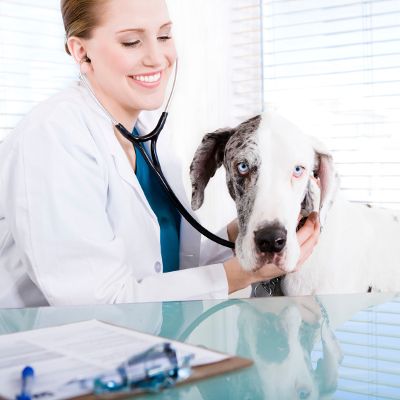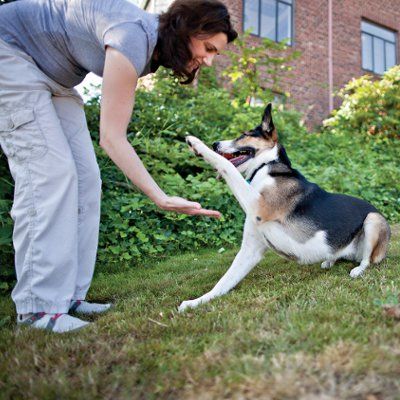By Tracy Libby for The Dog Daily
 When dog owner Melody Peterson’s bull terrier, Shasta, ate Peterson’s carpet, the veterinary bill set the Bend, Oregon resident back $1,800. That’s the good news. The bad news is that subsequent veterinary visits due to complications cost her an additional $2,500. A year later, Shasta ate a mini blind cord and the price tag for emergency surgery cost Peterson another $1,800.
When dog owner Melody Peterson’s bull terrier, Shasta, ate Peterson’s carpet, the veterinary bill set the Bend, Oregon resident back $1,800. That’s the good news. The bad news is that subsequent veterinary visits due to complications cost her an additional $2,500. A year later, Shasta ate a mini blind cord and the price tag for emergency surgery cost Peterson another $1,800.
All told, Peterson has shelled out more than $6,000 on veterinary bills because of her dog’s propensity to eat anything and everything in sight, be it plastic water bottles, rocks, carpets, cell phones, or mini blind cords. Shasta, who appears to have as many lives as a cat, is currently living the well-deserved life of a pampered pooch. Although Peterson’s pocketbook took a big hit, she doesn’t regret the money spent. She considers herself, and Shasta, quite fortunate.
While Peterson’s situation may be excessive, Americans spent an estimated $24.5 billion for veterinary expenditures in 2006, according to the American Veterinary Medical Association’s 2007 U.S. Pet Ownership & Demographics Sourcebook, with $16.1 billion of the pie chart going to canine veterinary care. While the AVMA estimates that dog owners spend on average $356 per year for veterinary care, the American Pet Products Manufacturers Association Inc., (APPMA) estimates the 2006 figure higher, at $672 per year for the average dog owner. Whether your own veterinary bills have fallen lower or higher than these averages, chances are you could have saved money.
Preventive care, according to Wendy Wallace, DVM, certified veterinary acupuncturist and owner of the Four Seasons Animal Hospital in Lafayette, California, is key to reducing veterinary costs. She recommends a proactive approach with the following 10 strategies:
-
 Feed well-balanced, good-quality dog food. This allows your dog to maximize nutrients while eating less, so your wallet benefits, too. “Correcting problems at this level may prevent the development of more serious problems,” says Dr. Wallace. Also, many human foods, including chocolate, mushrooms and grapes, can cause serious health problems, so never offer these to your dog.
Feed well-balanced, good-quality dog food. This allows your dog to maximize nutrients while eating less, so your wallet benefits, too. “Correcting problems at this level may prevent the development of more serious problems,” says Dr. Wallace. Also, many human foods, including chocolate, mushrooms and grapes, can cause serious health problems, so never offer these to your dog. - Keep your canine fit and trim. Keeping your dog at its right size can increase its life span by nearly two years. Dr. Wallace says overweight dogs are subject to diabetes; heart and respiratory problems; arthritis; increased surgical risks; decreased immune function; and increased damage to joints, bones, and ligaments. To reduce your dog’s weight, look for foods formulated for calorie restriction and exercise your dog daily, with walks, scheduled playtime, or other activities.
-
 Brush your dog’s teeth daily. This will not only prevent tartar buildup, but also periodontal disease -- a progressive disease that can, in advanced cases, lead to decayed gums, infection, and liver, kidney, and heart damage.
Brush your dog’s teeth daily. This will not only prevent tartar buildup, but also periodontal disease -- a progressive disease that can, in advanced cases, lead to decayed gums, infection, and liver, kidney, and heart damage. - Groom your pet weekly. This will help prevent hot spots, rashes, mats, and painful broken nails, which can require anesthesia to treat. “Hair and skin are reflective of nutritional health,” says Dr. Wallace. Daily inspections of the ears, nose, mouth, teeth, and feet can help you spot minor issues before they escalate into potentially life-threatening and expensive problems.
- Keep parasite prevention and vaccines current. Internal and external parasites, such as ticks and heartworms, and diseases like parvo, distemper, and hepatitis can require intensive hospitalized treatment for your canine, which is a great deal more expensive than the cost of vaccinating.
- Spay or neuter your dog. This way, you decrease the incidence of pyometra (a potentially life-threatening uterine infection), mammary cancer, unwanted pregnancies in females, and prostate infections in male dogs. Spaying or neutering also decreases the tendency to roam, which, in turn, decreases the odds your dog will fight with other animals or will be hit by a car.
-
 Dog-proof your home and yard. Store medications and all toxic products in a safe place. Keep poisonous plants, cell phones, slippers, marbles, dolls, and other choking hazards out of reach. Secure all fences and gates.
Dog-proof your home and yard. Store medications and all toxic products in a safe place. Keep poisonous plants, cell phones, slippers, marbles, dolls, and other choking hazards out of reach. Secure all fences and gates. - Schedule (and keep!) regular checkups. It is especially important to keep those that include laboratory testing, such as blood chemistries, complete blood cell counts, and urinalysis. “This allows detection of disease early when it is likely to be more treatable and prevent or extend the quality of life before more expensive procedures are necessary,” says Dr. Wallace.
- Train your dog. “If your dog is comfortable being handled, having his ears, feet, and mouth looked at, it allows the veterinarian to do many procedures safely, such as examining and treating ears, removing foreign bodies, and caring for wounds, less expensively and without general anesthesia,” says Dr. Wallace.
-
 Consider purchasing pet insurance. Pet insurance can act as a safeguard against unexpected illnesses and accidents. But be sure to shop around. Prices, plans, and coverage vary from company to company.
Consider purchasing pet insurance. Pet insurance can act as a safeguard against unexpected illnesses and accidents. But be sure to shop around. Prices, plans, and coverage vary from company to company.
Following these simple and very doable guidelines will help you keep a leash on veterinary bills. Equally important, they will assure that your dog has the best chance to live a long, happy, and healthy life, thereby increasing the enjoyment you share with your best canine friend.
Tracy Libby has authored six books about dogs, including Building Blocks for Performance (Alpine 2002). She exhibits Australian shepherds in obedience and conformation and also shares her home with six cats.




